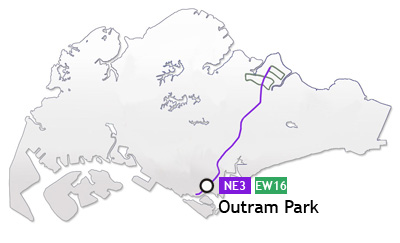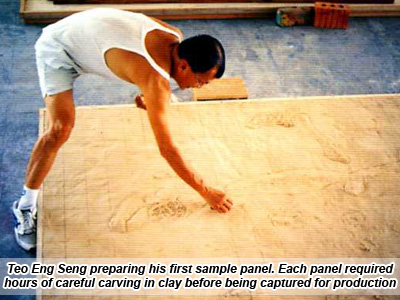|

Outram Park station

Outram Park interchange
station is the second deepest station along the North East
Line, after Dhoby Ghaut. Built under the junction of Eu Tong
Sen Street,
Cantonment Road and Outram Road, the station is connected by
an underground linkway to the existing Outram Park station
on the East West Line. Commuters can
transfer seamlessly between both lines, enjoying smoother
journeys. A covered linkway leading to a bus terminal
ensures the comfort and ease of those switching
from the MRT to buses.
Made up of five levels
with a depth of 28 metres, the new Outram Park station
provides a network of underground pedestrian links to
several large developments
nearby, including health institutions such as the National
Dental Centre, Health Promotion Board and Health Science
Authority. Patients and visitors welcome the
direct links to the Singapore General Hospital.
Back To Top
Wang Lu Sheng created
artworks for Outram Park interchange that bear the imprint
of his training as a graphic designer. Bold, decorative,
graphic and impossible to
miss, the works of the China-born artist give the station
entrances where they are located a strong, distinctive
identity.

Instantly recognizable at
a glance, the brilliantly-coloured works serve as visual
signposts that help guide commuters through the sprawling MRT
interchange.
A Chinese opera mask
adorns the station entrance closest to Pearl's Centre. The
distinctive shape and strong colours of the mask pack a
visual punch and reminds
commuters about the early Chinese migrants who settled in
the area.

In the connecting subway,
form fuses with the function as another visual of the opera
mask is stretched horizontally for 25 metres into the
station interiors. The
horizontal colour bars stretching out from the mask seem to
point commuters towards the trains, functioning as an
unusual yet artistic arrow. Commuters who are on
their way out of the staion can trace the colour bars
backwards to the mask and be led out towards Pearl's Hill.

Back To Top
The second entrance at
Outram Park interchange leads to Singapore General Hospital
(SGH) while the third entrance links the interchange to the
Central Police
Headquarters.
Both entrances share a
single underpass that is 64 metres long and opens up to
almost 9 metres wide. Playing up the area's association with
the law and medicine,
the artist worked with historical images from the area such
as early photos of SGH and policemen inspired by the shape
of the human head.
By looking inside these
'heads', commuters can see a visual documentary of the area
and its history. One example of recent history captured in
Lu Sheng's work is
the rainbow-coloured Outram Park housing estate. Once a
colourful landmark that sat across from the SGH, these HDB
blocks were recently demolished as part of
urban redevelopment. Now, the colourful flats live on as
memories on the station walls.
In recognition of the
Chinese clan associations and music societies in the area,
the artist designed a large, striking opera costume for the
station's Cantonment Road
entrance.
In designing the opera
costume for the Cantonment Road entrance, the artist wanted
to continue the opera theme that began with the opera mask
at the Pearl's
Centre entrance.

Back To Top
All the artworks revolve
around the concept of "Memories", the artist's intention
being to recreate, within the station, memories of Outram
Park that are cherished by
those who live and work there.
Each work also makes a
historical connection with the entrance where it is
connected.
To get a feel of Outram
Park's history, the artist immersed himself in all aspects
of life at Outram Park. He spent numerous weekends walking
around the area, going
to the rooftops of shophouses and apartment blocks to get a
bird's eye view of the area.
The artist's designs were
fabricated in silkscreen on vitreous enamel by PG Bell, a
Canadian wall panel manufacturer. In Canada, the LTA
team
found that despite
their best efforts, not all the brilliant colours in Lu
Sheng's works reproduced well on vitreous enamel.
While history provided the
inspiration for his work, the artist deliberately used
contemporary techniques that would speak to present-day
commuters. The artist had
wanted to create lively, vibrant images which can capture
the attention of commuters even if they only have a few
seconds to spare. He also wanted to do it in the
bold, visual style of modern public art.
For the artist, being
involved in a public art project for the North East Line
marks the culmination of an interest in architecture and
design nurtured over twenty
years.
Artist:
Wang Lu Sheng
Born: Qingdao, China, 1956
Education:
- Bachelor of Arts & Crafts, 1984
Jiao Tong University, Shanghai
Back To Top
In the linkways of Outram
Park interchange, artist Teo Eng Seng has created a
thought-provoking artwork comprising wall reliefs of both
human and man-made
forms. Eng Seng's monochromatic images seem to pop in and
out of the concrete walls inviting close scrutiny from
commuters and stimulating discussion, as the
artist, no doubt, intended.
A sparkling ebullient
personality at his best, volatile at his worst and always
spirited, Teo Eng Seng doesn't pull any punches about his
works at Outram Park
interchange. He is also the Cultural Medallion winner for
1986 and had been the head of the Art department at United
World College.
His wall reliefs of the
human form in motion are certainly intriguing enough to
pique the curiosity of commuters over many trips though the
station. Each of the 69
wall panels measuring 2 metres by 2 metres was individually
fabricated by the artist.
Homing in on the 'public
nature' of the Art in Transit programme, Eng Seng focused on
the commuters themselves and their thoughts and feelings
while in
transit.
He describes his images as
"straight forward" yet there is a sense within his work of a
picture within a picture. The mental images that flash
across the minds of
commuters - what they ate for dinner, what a spouse or lover
said to them - are interwoven with advertising messages and
visuals directed at them.
Interestingly, his
subjects, whether office workers, monks, old people or
children, seem to blend into the wall or emerge out of it,
so only part of the individual is
discernible at any one time.

Back To Top
The blank spaces between
the images are deliberate, so as to leave something for your
imagination. Breathing spaces are also featured in his
larger body of works
employing paper on canvas and paper sculptures. The wall
friezes may smack of the surreal, but sinister they are not.
What is less apparent to
the casual onlooker is the way Eng Seng has cleverly
incorporated references to Outram Park and its history
throughout his work. The
Peranakan houses of the Bukit Pasoh area,
accessible from
the Cantonment Road exit, are alluded to by the outline of a
shophouse framed by a pair of legs, and the
Chinese roots of the area by a bold, expressionistic and far
from the traditional dragon.
The artist's peculiar
signpost for the Singapore General Hospital is the image of
a little girl jumping in the air. It seems that she is in a
hurry to visit her relative in the
hospital.
The image of a carefree
child on her way to visit a sick relative reflects Eng
Seng's gift for picking life's little quirks. The artist's
sense of humour however belies the
tenacity of his approach to his craft. The use of glass
reinforced cement or concrete, the ultimate medium for his
works in clay, were made before being transferred
to concrete.
Most of the work was done
from October 2000 to July 2001, at a concrete factory, Poh
Cheong Concrete Product, in Sungei Kadut. Working almost
non-stop, the
artist spent entire days astride a plank suspended over the
clay, sculpting each individual panel by hand.

The artist acknowledges
that it was a challenge to balance the requirements of a
public building with the demands of his craft, but looking
back on his work for
Outram Park interchange, he feels a certain sense of pride
and fondness.
Artist:
Teo Eng Seng
Born: Singapore, 1938
Education:
- BA (Hons) Fine Art, 1967
Birmingham College of Art & Design, England
- Art Teacher's Diploma, 1968
Birmingham, England
- Certificate of Education, 1968
Birmingham University, England
next: Chinatown station
Back To Top
|